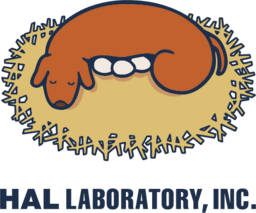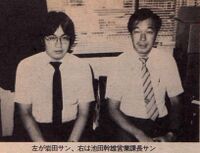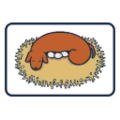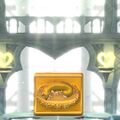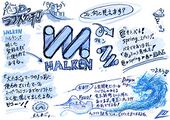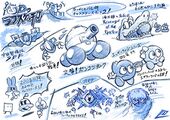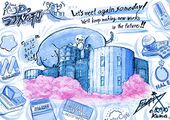HAL Laboratory: Difference between revisions
WillIdleAway (talk | contribs) m (→History) |
WillIdleAway (talk | contribs) m (→History) |
||
| Line 14: | Line 14: | ||
==History== | ==History== | ||
[[File:MSX Magazine 0 Iwata Ikeda photo.jpg|left|thumb|200px|Satoru Iwata (left) and Mikio Ikeda, photographed for issue 0 of ''MSX Magazine''. After HAL Laboratory spun off its non-Nintendo business into HAL Corporation, Iwata and Ikeda would head the two separated entities.]] | [[File:MSX Magazine 0 Iwata Ikeda photo.jpg|left|thumb|200px|Satoru Iwata (left) and Mikio Ikeda, photographed for issue 0 of ''MSX Magazine''. After HAL Laboratory spun off its non-Nintendo business into HAL Corporation, Iwata and Ikeda would head the two separated entities.]] | ||
===1980-1992, before ''Kirby''=== | |||
HAL Laboratory got its start in 1980 developing peripherals and games for personal computers, creating modest hits such as the ''[[wikipedia:Eggerland (series)|Eggerland]]'' series for the MSX. Starting in 1984, they would begin developing for Nintendo's hardware, collaborating on ''[[wikipedia:Pinball (1984 video game)|NES Pinball]]''<ref>[https://www.nsidr.com/archive/hal-laboratory-company-profile/2 HAL Laboratory: Company Profile - nsidr]</ref> and porting its ''Eggerland'' games to their consoles along with original titles such as ''Revenge of the 'Gator'' and ''New Ghostbusters II''. | HAL Laboratory got its start in 1980 developing peripherals and games for personal computers, creating modest hits such as the ''[[wikipedia:Eggerland (series)|Eggerland]]'' series for the MSX. Starting in 1984, they would begin developing for Nintendo's hardware, collaborating on ''[[wikipedia:Pinball (1984 video game)|NES Pinball]]''<ref>[https://www.nsidr.com/archive/hal-laboratory-company-profile/2 HAL Laboratory: Company Profile - nsidr]</ref> and porting its ''Eggerland'' games to their consoles along with original titles such as ''Revenge of the 'Gator'' and ''New Ghostbusters II''. | ||
However, the company was on the verge of bankruptcy by 1992, a typical victim of the [[wikipedia:Japanese asset price bubble|disastrous aftermath of the Japanese asset price bubble]] (an event so singular that Japanese media simply refer to it as [[wikipedia:ja:バブル崩壊|バブル崩壊]] or "''the bubble collapse''"). A legendary figure in this period of hardship was ''[[wikipedia:Metal Slader Glory|Metal Slader Glory]]'', a costly and elaborate adventure game that took somewhere between four and six years to develop.<ref name="shmuplations_msg">[https://shmuplations.com/metalsladerglory/ Metal Slader Glory – Developer Interview Collection], Peter Barnard's translation of two interviews with ''Metal Slader Glory'' director Yoshimiru Hoshi</ref><ref name="hobonichi_sakurai">[https://www.1101.com/about_iwatasan/sakurai/2020-01-30.html Shigesato Itoi's interview with Masahiro Sakurai about Satoru Iwata]</ref> The early days of this long development cycle happened to coincide with the heights of the bubble boom while the game would only be finished in time to release as the bubble was about to burst. Although the game's director would claim that the game was successful enough for the initial (and only) production run to quickly sell out,<ref name="shmuplations_msg"/> ''Glory'' was a focal point for HAL Laboratory's internal disarray, with Masahiro Sakurai recalling overhearing a furious Satoru Iwata in management discussions about how the company could possibly recoup ''Glory'''s development costs.<ref name="hobonichi_sakurai"/> While Iwata would later describe ''Glory'' as a mistake (「間違い」) strictly from a management perspective, he also recalled a larger vicious cycle at HAL Laboratory of pushing unsatisfactory games to release to recoup development costs, only for this to result in poor reception and sales that put further pressure on subsequent games to recoup costs.<ref name="shmuplations_iwata"/> | However, the company was on the verge of bankruptcy by 1992, a typical victim of the [[wikipedia:Japanese asset price bubble|disastrous aftermath of the Japanese asset price bubble]] (an event so singular that Japanese media simply refer to it as [[wikipedia:ja:バブル崩壊|バブル崩壊]] or "''the bubble collapse''"). A legendary figure in this period of hardship was ''[[wikipedia:Metal Slader Glory|Metal Slader Glory]]'', a costly and elaborate adventure game that took somewhere between four and six years to develop.<ref name="shmuplations_msg">[https://shmuplations.com/metalsladerglory/ Metal Slader Glory – Developer Interview Collection], Peter Barnard's translation of two interviews with ''Metal Slader Glory'' director Yoshimiru Hoshi</ref><ref name="hobonichi_sakurai">[https://www.1101.com/about_iwatasan/sakurai/2020-01-30.html Shigesato Itoi's interview with Masahiro Sakurai about Satoru Iwata]</ref> The early days of this long development cycle happened to coincide with the heights of the bubble boom while the game would only be finished in time to release as the bubble was about to burst. Although the game's director would claim that the game was successful enough for the initial (and only) production run to quickly sell out,<ref name="shmuplations_msg"/> ''Glory'' was a focal point for HAL Laboratory's internal disarray, with Masahiro Sakurai recalling overhearing a furious Satoru Iwata in management discussions about how the company could possibly recoup ''Glory'''s development costs.<ref name="hobonichi_sakurai"/> While Iwata would later describe ''Glory'' as a mistake (「間違い」) strictly from a management perspective, he also recalled a larger vicious cycle at HAL Laboratory of pushing unsatisfactory games to release to recoup development costs, only for this to result in poor reception and sales that put further pressure on subsequent games to recoup costs.<ref name="shmuplations_iwata"/> | ||
It was against this background of financial difficulty and management conflicts that Sakurai was developing a beginner-friendly platforming game called ''Twinkle☆Popo'', which Nintendo would then offer to market and publish once the game was reborn as ''Kirby's Dream Land''. On a larger scale, Nintendo would help HAL Laboratory repay its ¥1.5 billion debt on the condition that Iwata was appointed as President of HAL Laboratory. Nintendo was already familiar with Iwata, who had driven HAL's entry into Famicom game development, and his leadership and Nintendo's investment (including into the sales and marketing of HAL's games) would see HAL Laboratory focus on breaking the vicious cycle that led to the company's financial hardship.<ref name="shmuplations_iwata">Interview with Satoru Iwata in [https://retrocdn.net/images/3/33/UsedGames_JP_12.pdf ''Used Games'' magazine, volume 12 (1999 autumn)] ([https://shmuplations.com/iwata/ shmuplations.com translation])</ref> | ===1992-present, with ''Kirby''=== | ||
It was against this background of financial difficulty and management conflicts that Sakurai was developing a beginner-friendly platforming game called ''Twinkle☆Popo'', which Nintendo would then offer to market and publish once the game was reborn as ''Kirby's Dream Land''.<ref>{{cite person|quote=あのタイトルでゲームボーイのソフトとして出す予定でしたが、「もったいない」と宮本茂さんがおっしゃって、調整して、任天堂発売の『星のカービィ』に変わるんですね。" Translation: "We were going to release it under that title, but then Shigeru Miyamoto-san said 'mottainai' ''['it would be a shame', or even 'what a waste' in its most direct use]'', so we tuned it up and changed it into the Nintendo-published Kirby of the Stars [Kirby's Dream Land].|name=[[Satoru Iwata]]|url=https://www.1101.com/president/iwata07.html|title=ほぼ日刊イトイ新聞 - 社長に学べ!}}</ref> On a larger scale, Nintendo would help HAL Laboratory repay its ¥1.5 billion debt on the condition that Iwata was appointed as President of HAL Laboratory. Nintendo was already familiar with Iwata, who had driven HAL's entry into Famicom game development, and his leadership and Nintendo's investment (including into the sales and marketing of HAL's games) would see HAL Laboratory focus on breaking the vicious cycle that led to the company's financial hardship.<ref name="shmuplations_iwata">Interview with Satoru Iwata in [https://retrocdn.net/images/3/33/UsedGames_JP_12.pdf ''Used Games'' magazine, volume 12 (1999 autumn)] ([https://shmuplations.com/iwata/ shmuplations.com translation])</ref> | |||
A part of the original company split off in 1992 to become HAL Corporation,<ref name="halcorp_corpinf">[http://web.archive.org/web/19980629060624/http://www.halcorp.co.jp/Company/ 株式会社ハル・コーポレーション会社概要] (Wayback Machine snapshot from 1998; note in particular the date of establishment, 設立 : 1992年8月3日)</ref> which would continue previous work on non-Nintendo products, such as new entries to the ''Eggerland'' series for [[wikipedia:Microsoft Windows|Windows]] computers,<ref>[http://web.archive.org/web/20020219085405/http://www.halcorp.co.jp/soft/newegg/index.htm HAL Corporation page for 「復活!エッガーランド」]; the company also featured artwork of [http://web.archive.org/web/19980629060611im_/http://www.halcorp.co.jp/Items/Amusment/EggerLand/Images/infololo.gif Lolo] and [http://web.archive.org/web/19980629060556im_/http://www.halcorp.co.jp/Items/Amusment/EggerLand/Images/rara.gif Lala] on [http://web.archive.org/web/19980629060459/http://www.halcorp.co.jp/ its website]</ref> and updated versions of the 1990 Good Design Award-winning Crossam 2 universal remote.<ref>A press release about the Crossam 2 Plus, circulated to publications like [https://ascii.jp/elem/000/000/328/328627/ ASCII] and [https://av.watch.impress.co.jp/docs/20020117/hal.htm AV Watch], would be one of the final pieces of news from HAL Corporation.</ref> This entity appears to have gone defunct sometime in 2002.<ref>[http://fryguy64.proboards.com/index.cgi?action=display&board=classic&thread=3972 To what extent is HAL Laboratory "Nintendo"? | NinDB Boards Jun 26, 2011]</ref><ref>While no official source exists to confirm the timing of HAL Corporation's demise, both [[wikipedia:ja:エッガーランド#シリーズの歴史|the Japanese Wikipedia page on the ''Eggerland'' series]] and [https://w.atwiki.jp/aniwotawiki/pages/27616.html Aniwota Wiki's entry on HAL Laboratory] suggest that the company dissolved in 2002, supported by the company's website becoming inaccessible beyond March of 2002 ([http://web.archive.org/web/20020311000000*/http://www.halcorp.co.jp:80/download/index.htm example]).</ref> | A part of the original company split off in 1992 to become HAL Corporation,<ref name="halcorp_corpinf">[http://web.archive.org/web/19980629060624/http://www.halcorp.co.jp/Company/ 株式会社ハル・コーポレーション会社概要] (Wayback Machine snapshot from 1998; note in particular the date of establishment, 設立 : 1992年8月3日)</ref> which would continue previous work on non-Nintendo products, such as new entries to the ''Eggerland'' series for [[wikipedia:Microsoft Windows|Windows]] computers,<ref>[http://web.archive.org/web/20020219085405/http://www.halcorp.co.jp/soft/newegg/index.htm HAL Corporation page for 「復活!エッガーランド」]; the company also featured artwork of [http://web.archive.org/web/19980629060611im_/http://www.halcorp.co.jp/Items/Amusment/EggerLand/Images/infololo.gif Lolo] and [http://web.archive.org/web/19980629060556im_/http://www.halcorp.co.jp/Items/Amusment/EggerLand/Images/rara.gif Lala] on [http://web.archive.org/web/19980629060459/http://www.halcorp.co.jp/ its website]</ref> and updated versions of the 1990 Good Design Award-winning Crossam 2 universal remote.<ref>A press release about the Crossam 2 Plus, circulated to publications like [https://ascii.jp/elem/000/000/328/328627/ ASCII] and [https://av.watch.impress.co.jp/docs/20020117/hal.htm AV Watch], would be one of the final pieces of news from HAL Corporation.</ref> This entity appears to have gone defunct sometime in 2002.<ref>[http://fryguy64.proboards.com/index.cgi?action=display&board=classic&thread=3972 To what extent is HAL Laboratory "Nintendo"? | NinDB Boards Jun 26, 2011]</ref><ref>While no official source exists to confirm the timing of HAL Corporation's demise, both [[wikipedia:ja:エッガーランド#シリーズの歴史|the Japanese Wikipedia page on the ''Eggerland'' series]] and [https://w.atwiki.jp/aniwotawiki/pages/27616.html Aniwota Wiki's entry on HAL Laboratory] suggest that the company dissolved in 2002, supported by the company's website becoming inaccessible beyond March of 2002 ([http://web.archive.org/web/20020311000000*/http://www.halcorp.co.jp:80/download/index.htm example]).</ref> | ||
Revision as of 20:56, 16 May 2023
| ||||||||||||||||||
| ||||||||||||||||||
|
| ||||||||||||||||||
HAL Laboratory, Inc. (also known as HAL Labs and previously HALKEN) is a Japanese video game development company closely affiliated with Nintendo throughout its history. One of its founding members, Satoru Iwata, eventually became the president of Nintendo of Japan. Among the company's many creations are the Kirby series and Super Smash Bros. series.
History
1980-1992, before Kirby
HAL Laboratory got its start in 1980 developing peripherals and games for personal computers, creating modest hits such as the Eggerland series for the MSX. Starting in 1984, they would begin developing for Nintendo's hardware, collaborating on NES Pinball[1] and porting its Eggerland games to their consoles along with original titles such as Revenge of the 'Gator and New Ghostbusters II.
However, the company was on the verge of bankruptcy by 1992, a typical victim of the disastrous aftermath of the Japanese asset price bubble (an event so singular that Japanese media simply refer to it as バブル崩壊 or "the bubble collapse"). A legendary figure in this period of hardship was Metal Slader Glory, a costly and elaborate adventure game that took somewhere between four and six years to develop.[2][3] The early days of this long development cycle happened to coincide with the heights of the bubble boom while the game would only be finished in time to release as the bubble was about to burst. Although the game's director would claim that the game was successful enough for the initial (and only) production run to quickly sell out,[2] Glory was a focal point for HAL Laboratory's internal disarray, with Masahiro Sakurai recalling overhearing a furious Satoru Iwata in management discussions about how the company could possibly recoup Glory's development costs.[3] While Iwata would later describe Glory as a mistake (「間違い」) strictly from a management perspective, he also recalled a larger vicious cycle at HAL Laboratory of pushing unsatisfactory games to release to recoup development costs, only for this to result in poor reception and sales that put further pressure on subsequent games to recoup costs.[4]
1992-present, with Kirby
It was against this background of financial difficulty and management conflicts that Sakurai was developing a beginner-friendly platforming game called Twinkle☆Popo, which Nintendo would then offer to market and publish once the game was reborn as Kirby's Dream Land.[5] On a larger scale, Nintendo would help HAL Laboratory repay its ¥1.5 billion debt on the condition that Iwata was appointed as President of HAL Laboratory. Nintendo was already familiar with Iwata, who had driven HAL's entry into Famicom game development, and his leadership and Nintendo's investment (including into the sales and marketing of HAL's games) would see HAL Laboratory focus on breaking the vicious cycle that led to the company's financial hardship.[4]
A part of the original company split off in 1992 to become HAL Corporation,[6] which would continue previous work on non-Nintendo products, such as new entries to the Eggerland series for Windows computers,[7] and updated versions of the 1990 Good Design Award-winning Crossam 2 universal remote.[8] This entity appears to have gone defunct sometime in 2002.[9][10]
Meanwhile, HAL Laboratory focused exclusively on developing Nintendo products, such as their newly-introduced Kirby, while providing development support for other titles such as EarthBound and Pokémon Stadium. By 1999, HAL Laboratory paid off its debt, and Iwata was offered a position at Nintendo as the Head of Corporate Planning. He later became Nintendo's president, and held this position until his death in 2015. In July of 2001, at the time of production of the anime Kirby: Right Back at Ya!, HAL Laboratory and Nintendo would establish a joint subsidiary, "Warpstar, Inc.", to manage the Kirby intellectual property and copyright. Warpstar, Inc. still exists and manages the Kirby brand in the present day.[11] To this day, HAL continues to primarily develop for Nintendo platforms, and creates new entries to the Kirby series, as well as other original titles such as Picross 3D, BOXBOY!, and Part Time UFO (the last via its mobile development branch, HAL Egg).
HAL's corporate headquarters are in Kanda, a region of the Chiyoda ward of Tokyo. They share the building with Nintendo, its subsidiaries, and Game Freak. They also have a development center in Kai, Yamanashi, where Mt. Fuji features prominently in the skyline. The company's Tokyo development center was originally located in the Nintendo Tokyo Prefecture Building in Nihonbashi, Chuo, Tokyo, before consolidation in 2003; until 2020, the Tokyo headquarters were in a separate building in Kanda. The image of HAL's Yamanashi building features in several of the company's products. As of July 2021, the company has 205 employees.
Logo
The corporate logo is known as the Dream Hatcher[12] (a.k.a. Inutamago; 犬たまご "Dog Eggs"[13]), which depicts a dog similar to a dachshund incubating several eggs. According to a 2003 Nintendo Power interview about Kirby Air Ride, producer Masayoshi Tanimura notes that the dog is a fictional creation and that the team does not think of the dog like a dachshund. Tanimura explains that the logo represents deep thought into "incubating completely new ideas that eventually hatch into incredibly fun games".[14] Shigesato Itoi conceived the logo and pitched it to HAL, and introduced the company to Gugi Akiyama to create the final design of the logo.[15] The Dream Hatcher has been the symbol of HAL Laboratory since December 1998.
The logo immediately preceding the Dream Hatcher, seen in games like Kirby Super Star and Kirby's Dream Land 3, was the "spring" logo (「バネ」マーク) introduced in February of 1991.[16][17] In artwork for the October 2021 issue of Nintendo Dream magazine, Shinya Kumazaki notes a possible game of word association, from "spring" in the sense of a metal coil, to "spring" in the sense of the season, which translates to 春 (haru) in Japanese, homophonic with the company's name.[18]
Video game series produced by HAL
Notable video game series produced by HAL include:
- Eggerland / Adventures of Lolo
- Lololo & Lalala originated from this series.
- Kirby
- Super Smash Bros.
- Super Smash Bros. (Nintendo 64) and Super Smash Bros. Melee were developed by HAL themselves.
- Later titles were developed by other studios.
- BOXBOY!
- Part Time UFO
- Released under HAL's mobile game brand: HAL Egg. Later released on Nintendo Switch on October 28, 2020, under HAL Laboratory & Nintendo.
HAL was also involved in the creation and/or localization of EarthBound, Sim City 2000, various Pokémon spin-off titles, and others. They have also worked on hardware for Nintendo, including for the Nintendo Switch.
For the full list of HAL's works, see this link.
Notable staff of HAL Laboratory (past and present)
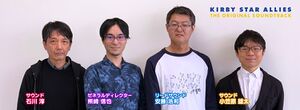
Presidents
The following people are past and present Presidents of HAL Laboratory.[19]
- Mitsuhiro Ikeda (February 1980–March 1984)
- Tsuyoshi Ikeda (March 1984–March 1993)
- Satoru Iwata (March 1993–June 1999)
- Masayoshi Tanimura (June 1999–June 2015)
- Satoshi Mitsuhara (June 2015–September 2018)
- Shigefumi Kawase (September 2018–present)
Key Creators
- Masahiro Sakurai
- Hiroaki Suga
- Shinichi Shimomura
- Shinya Kumazaki
- Tadashi Kamitake
- Tatsuya Kamiyama
- Yuki Endo
- Yumi Todo
- Riki Fuhrmann
- Kenichiro Kita
- Shigeru Hashiguchi
- Tetsuya Abe
Composers
- See also: HAL Laboratory music equipment
References to HAL in the Kirby series

In many games of the Kirby series, HAL includes self-referential easter eggs, typical in the form of their name or the Dream Hatcher logo. The most famous of these are the hidden HAL Rooms, which appear in numerous Kirby games. The Japanese pronunciation of HAL (ハル) can be separated into 8 (は) and 6 (る). Some HAL Rooms can only be entered if the player waits in a certain area for 86 seconds. Furthermore, some games, such as Dedede's Drum Dash Deluxe and Kirby Star Allies, award a high score of 86,555 under special circumstances. In Japanese, 5 is pronounced as "go" (ご), making it "HAL go go go". Team Kirby Clash also awards 39,860 experience points upon reaching level ten: "39" is read as san-kyu, or the English phrase "thank you", making it "thank you, HAL".
Besides this, several names of characters, places, and objects in the Kirby series may be references to HAL, such as the Halberd, Halcandra, Haldera Volcano, President Haltmann, and his Haltmann Works Company. The three levels in New Challenge Stages of Kirby's Dream Collection Special Edition are named Happiness Hall, Apricot Atrium, and Last Land, and in Kirby and the Forgotten Land, three major companies seen throughout the stages are named Holine, Alivel, and Lightron. Also in Kirby and the Forgotten Land, Fecto Forgo's ID number, ID-F86, is another reference to HAL. The race car used for Car Mouth in Circuit Speedway also has "86" on its side.
The Japanese version of Kirby Star Allies has many references to HAL through its fictional language. The fortress Jambastion is called ジャマハルダ (Jamahalda). The base Jambandra is called マジュハルガロア (Majuhalgalor), and the HAL letters can also be found on the surface of Jambandra. The Staff ability enemy, Jammerjab, is called ジャハルビート (Jahal Beat). The weaponless Jammerjab counterpart is called ジャハルビリーバ (Jahal Believer).
There are several references to HAL's other works within the Kirby series. For example, Lololo & Lalala come from the Eggerland series (where they are named Lolo and Lala), and Moto Shotzo is based on the main character of the game Trax. The Kirby Quest mode in Kirby Mass Attack references Arcana, which was Kirby's technical debut as a character; he cameos in the opening sequence. Qbby from the BOXBOY! series has also made several cameo appearances in the Kirby series, and vice-versa. Symbols of HAL often appear in the Stone ability's transformations, such as the Dream Hatcher and HAL's Yamanashi headquarters.
Gallery
Stone Kirby's transformation in Kirby's Return to Dream Land of the Dream Hatcher
Stone Kirby's transformation in Kirby: Triple Deluxe of the Dream Hatcher
Archer Kirby in Kirby: Triple Deluxe camouflaging behind a cardboard illustration of the Dream Hatcher
Keychain in Kirby: Triple Deluxe of Stone Kirby's transformation in Kirby Super Star Ultra of the Dream Hatcher
Circus Kirby's Balloon Pop Art in Kirby: Planet Robobot (which also appears in Kirby: Triple Deluxe) of the Dream Hatcher
Stone Kirby's transformation in Kirby Star Allies of the Dream Hatcher
Stone Kirby's transformation in Kirby's Return to Dream Land Deluxe of the Dream Hatcher
"Dir. Kumazaki, from HAL Laboratory Where You Can See Mount Fuji"
Shinya Kumazaki drew these illustrations for a limited series of columns contributed to Nintendo DREAM magazine in 2021. These were then shared on HAL Laboratory's Twitter account in contemporaneous posts.
The spring logo preceding the Dream Hatcher, with other characters on the periphery: the Dream Hatcher, a Bouncy, and a dragon king referring to the Yamanashi building's location in Ryuoshinmachi, Kai, Yamanashi
External links
- Official website
- Official Twitter
- Official YouTube channel (with footage of many video games developed by HAL in the past)
References
- ↑ HAL Laboratory: Company Profile - nsidr
- ↑ 2.0 2.1 Metal Slader Glory – Developer Interview Collection, Peter Barnard's translation of two interviews with Metal Slader Glory director Yoshimiru Hoshi
- ↑ 3.0 3.1 Shigesato Itoi's interview with Masahiro Sakurai about Satoru Iwata
- ↑ 4.0 4.1 Interview with Satoru Iwata in Used Games magazine, volume 12 (1999 autumn) (shmuplations.com translation)
- ↑ "あのタイトルでゲームボーイのソフトとして出す予定でしたが、「もったいない」と宮本茂さんがおっしゃって、調整して、任天堂発売の『星のカービィ』に変わるんですね。" Translation: "We were going to release it under that title, but then Shigeru Miyamoto-san said 'mottainai' ['it would be a shame', or even 'what a waste' in its most direct use], so we tuned it up and changed it into the Nintendo-published Kirby of the Stars [Kirby's Dream Land]." –Satoru Iwata (ほぼ日刊イトイ新聞 - 社長に学べ!)
- ↑ 株式会社ハル・コーポレーション会社概要 (Wayback Machine snapshot from 1998; note in particular the date of establishment, 設立 : 1992年8月3日)
- ↑ HAL Corporation page for 「復活!エッガーランド」; the company also featured artwork of Lolo and Lala on its website
- ↑ A press release about the Crossam 2 Plus, circulated to publications like ASCII and AV Watch, would be one of the final pieces of news from HAL Corporation.
- ↑ To what extent is HAL Laboratory "Nintendo"? | NinDB Boards Jun 26, 2011
- ↑ While no official source exists to confirm the timing of HAL Corporation's demise, both the Japanese Wikipedia page on the Eggerland series and Aniwota Wiki's entry on HAL Laboratory suggest that the company dissolved in 2002, supported by the company's website becoming inaccessible beyond March of 2002 (example).
- ↑ Iwata Asks: Kirby's Epic Yarn - Nintendo UK
- ↑ This is what the Kirby: Planet Robobot Sticker depicting the logo is named.
- ↑ How Inutamago came to be - Interview about the Dream Hatcher symbol on the official website
- ↑ NP Interviews HAL Laboratories about Kirby Air Ride! | IGN Boards Dec 30, 2003
- ↑ ほぼ日刊イトイ新聞 - 樹の上の秘密基地 第4弾
- ↑ 沿革 | COMPANY | ハル研究所
- ↑ Twitter link

- ↑ Twitter link (direct image link)
- ↑ https://www.hallab.co.jp/eng/company/history/
| ||||||||||||||
